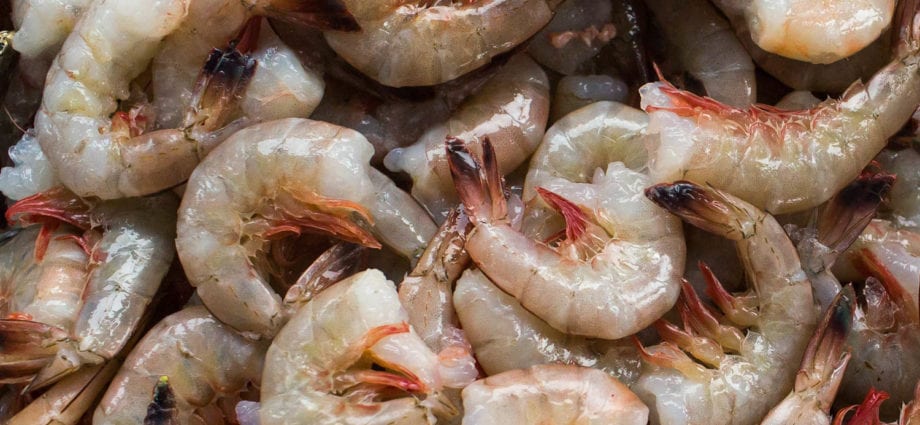Contents
How to choose the right shrimp size
The shrimp buyer usually deals with frozen food. Unnamed shrimp by weight are the cheapest, and with them we run the risk of getting snow, ice and more than once thawed seafood. A good manufacturer will carefully pack the goods, leave a window on the packaging so that you can be sure of the reality of the declared caliber of the content. And the content is very different.
Atlantic, cold water the shrimp is not large, and its calibers look like this: 50–70 (pieces per kilogram) – selected shrimps; 70–90 – medium; 90–120 are small. The colder the water in which the shrimp live, the smaller and juicier they are. Northern deep-sea shrimps rarely reach large sizes 31–40. Such shrimps are wonderfully suitable for preparing salads, appetizers, serving soups, and very small ones are often used in Scandinavian cuisine for toasts and smorrebrods.
Tropical, or warm water, shrimp are divided into two main types: tiger and king. They are much larger than cold-water ones (up to 25 cm long) and the calibers for them are as follows: 31–40; 21-30; 16–20; 12-16; 8-12; 6-8; 4-6; 2-4. Representatives of the latest calibers are real monsters compared to the Atlantic small fry. And this is reflected primarily in the price, which is several times higher. Eat this and, as they say, “”. Large shrimps are cooked on their own and are usually served with vegetables.
Shrimp selection: whole, cut and peeled
Shrimp are sold uncut, cut (headless), or peeled (headless and shellless). Unfinished – cheaper. But this does not mean that buying them is more profitable. For 1 kg of peeled, there are about 3 kg of unpeeled.
The cut shrimps are calibrated in the same way per piece, but not per kilogram, but per English pound (454 grams). For what reasons the manufacturers left the pounds, remained a mystery. And there are also originals that express the caliber by letter designation, like clothing sizes, for example, XL or XXL. Here, until you look into the package, you will not understand where this shrimp has sixty, and where ninety.
But there is also a hint here: on any foreign packaging there will certainly be words that more or less define the caliber. – these are most often shrimp from warm waters. – cold-wave shrimps, the caliber of which is almost always below 31–40.
All the pros of choosing smaller shrimp
There are many nuances in the ratio “size – price”. It is easier to cook with large shrimps, especially popular with chefs Tiger chrimp with characteristic stripes on the shell, which are grown on farms in the Mediterranean, Malaysia, Taiwan and other countries of Southeast Asia. We also sell a huge shrimp jumbo – up to 30 cm long.
In many countries, where size is more relaxed, namely atlantic cold-water shrimp is a great exotic both due to its taste and high content of vitamins, and because of the relatively small catch, which makes up a few percent of the catch volume of warm-water shrimp. We are talking about selected 50-70 caliber Atlantic shrimp. “Seeds” of caliber 120 and above are already “krill”. It should also be borne in mind that the shell of shrimp is also used to make shrimp flavorings and “crayfish oil”, while the Atlantic flavor is more. So, despite the loud epithets about tigers and kings, the meat of the smaller Atlantic shrimp is valued higher all over the world.
Shrimp enrobing
Covering seafood and fish, and individually, with a thin layer of ice is called glazing… It prevents weight loss during long-term storage and maintains quality. Immediately after the catch, right on the trawler, shrimp are boiled in sea water, and then very quickly frozen at a temperature of -25-30 ° C.
But anything that the consumer cannot check immediately leads unscrupulous suppliers into temptation. The percentage of glazing, that is, actually ice, in the final product should be 4% according to our GOSTs. But most independent tests show an ice content of 10 to 40%.
What is good …
The frozen shrimp has an even color, a thin “glaze” and a curled tail.
The caliber on the package matches the caliber on the price tag.
A brown head is a sign of a pregnant shrimp, its meat is very healthy.
A green head occurs in individuals that feed on a certain type of plankton. And there is nothing wrong with that.
… And what is bad
Faded spots on the shell and lumps of snow in the bag – the thermal regime was violated during storage.
If the shrimp looks like a piece of ice, then it was dipped in water to swell, and then frozen.
The black head reports that the shrimp was in pain.










